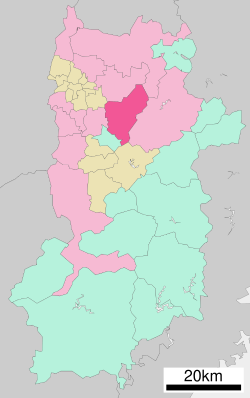Sakurai, Nara
Sakurai
桜井市 | |
|---|---|
 Top:A panorama view of Mount Miwa and Yamato River, Second:Ōmiwa Shrine,
A heritage site of Hashihaka Tomb, Bottom:Hase Temple, Tanzan Shrine (all item from left to right) | |
 | |
 Location of Sakurai in Nara Prefecture | |
| Coordinates: 34°31′07″N 135°50′36″E / 34.51861°N 135.84333°E | |
| Country | Japan |
| Region | Kansai |
| Prefecture | Nara |
| Village established | April 1, 1889 |
| Town established | November 18, 1890 |
| City established | September 1, 1956 |
| Government | |
| • Mayor | Akira Hasegawa |
| Area | |
• Total | 98.91 km2 (38.19 sq mi) |
| Population (October 31, 2024) | |
• Total | 54,384 |
| • Density | 550/km2 (1,400/sq mi) |
| Time zone | UTC+9 (Japan Standard Time) |
| Phone number | 0744-42-9111 |
| Address | 432-1, Odono, Sakurai-shi, Nara-ken 633-8585 |
| Website | Official website |
| Symbols | |
| Flower | Prunus jamasakura |
| Tree | Cryptomeria |

Sakurai (桜井市, Sakurai-shi) is a city located in Nara Prefecture, Japan. As of 31 August 2024[update], the city had an estimated population of 54,384 in 25678 households, and a population density of 550 persons per km2.[1] The total area of the city is 98.91 km2 (38.19 sq mi).[2]
Geography
[edit]Sakurai is located in central Nara Prefecture. The western and northern parts of the city are located southeast of the Nara Basin, and are relatively flat rural areas with the Terakawa and Hatsusegawa (Yamatogawa) rivers flowing through them. The urban area is centered around Sakurai Station and Miwa Station, and along National Route 165. The Ryumon Mountains cover the southern and eastern parts of the city,
Neighboring municipalities
[edit]Climate
[edit]Sakurai has a humid subtropical climate (Köppen Cfa) characterized by warm summers and cool winters with light to no snowfall. The average annual temperature in Sakurai is 14.2 °C. The average annual rainfall is 1636 mm with September as the wettest month. The temperatures are highest on average in August, at around 26.4 °C, and lowest in January, at around 2.7 °C.[3]
Demographics
[edit]Per Japanese census data, the population of Sakurai is as shown below
| Year | Pop. | ±% |
|---|---|---|
| 1960 | 47,752 | — |
| 1970 | 52,081 | +9.1% |
| 1980 | 56,439 | +8.4% |
| 1990 | 60,262 | +6.8% |
| 2000 | 63,248 | +5.0% |
| 2010 | 60,146 | −4.9% |
| 2020 | 54,857 | −8.8% |
History
[edit]Sakurai is part of ancient Yamato Province. Fragments of pottery from the Jomon and Yayoi periods can be found in ordinary fields, indicating that the area has been settled for many thousands of years. Many ancient burial mounds, such as zenpokoenfun from the Kofun periods, indicate that this was central region of the Yamato dynasty, and its predecessor, the Miwa dynasty. It was briefly the capital of Japan during the reign of Emperor Yūryaku.[4] The life of the Imperial court was centered at Hatsuse no Asakura Palace where the emperor lived in 457–479.[5] Other emperors also built palaces in the area, including
- Iware no Mikakuri Palace, 480–484[5] in reign of Emperor Seinei[6]
- Nimiki Palace, 499–506 in reign of Emperor Buretsu[7]
- Iware no Tamaho Palace, 526–532[5] in reign of Emperor Keitai[8]
- Hinokuma no Iorino Palace, 535-539[5] in reign of Emperor Senka[9]
- Osata no Sakitama Palace or Osada no Miya, 572–585[10] in reign of Emperor Bidatsu[11]
The village of Sakurai was established on April 1, 1889 with the creation of the modern municipalities system. It was raised to town status on November 1, 1890. Sakurai annexed the villages of Jojima in 1942 and Abe, Tonomine and Asakura in 1954. On September 1, 1956 Sakurai annexed Daifuku and Kaguyama and was raised to city status.
Government
[edit]Sakurai has a mayor-council form of government with a directly elected mayor and a unicameral city council of 16 members. Sakurai contributes two members to the Nara Prefectural Assembly. In terms of national politics, the city is part of the Nara 3rd district of the lower house of the Diet of Japan.
Economy
[edit]As it is a distribution center for lumber from all over Nara Prefecture, the lumber industry is thriving, and lumber is actively promoted through exhibitions of wood products and wood workshops. Agriculture is also important to the local economy and the area is also famous as a mandarin orange production area.
Education
[edit]Sakurai has 11 public elementary schools and four public junior high schools operated by the city government and two public high schools operated by the Nara Prefectural Board of Education.
Transportation
[edit]Railways
[edit]![]() JR West - Sakurai Line (Manyō-Mahoroba Line)
JR West - Sakurai Line (Manyō-Mahoroba Line)
Highways
[edit]Sister cities
[edit] Kumano, Mie, Japan
Kumano, Mie, Japan Taisha, Shimane, Japan
Taisha, Shimane, Japan Chartres, France
Chartres, France
Local attractions
[edit]Sakurai is home to Ōmiwa Shrine, traditionally considered one of the oldest Shinto shrines in Japan dedicated to the god of sake. Sake dealers across Japan often hang a wooden sugi ball, made at Ōmiwa Shrine, as a talisman to the god of sake. It was featured in Yukio Mishima's novel Runaway Horses.
Famous places
[edit]- Buddhist temples
- Abe Monju-in
- Asuka-dera
- Hase-dera
- Miwasanbyōdō-ji
- Seirin-ji
- Tachibana-dera
- Shinto shrines
- Kasayamakō Shrine
- Ōmiwa Shrine
- Tamatsura Shrine
- Tanzan Shrine
References
[edit]- ^ "Sakurai City official statistics" (in Japanese). Japan.
- ^ "面積および地勢" (PDF) (in Japanese). Japan: Sakurai City. Retrieved 23 April 2017.
- ^ Sakurai climate: Average Temperature, weather by month
- ^ Ponsonby-Fane. (1915). The Imperial Family of Japan, p. 13.
- ^ a b c d Koch, W. (1904). Japan; Geschichte nach japanischen Quellen und ethnographische Skizzen. Mit einem Stammbaum des Kaisers von Japan, p. 13.
- ^ Ponsonby-Fane, p. 14; excerpt, "Mikaguri Palace"
- ^ Ponsonby-Fane, p. 15.
- ^ Ponsonby-Fane, p. 16.
- ^ Ponsonby-Fane, p. 17.
- ^ Brown, Delmer. (1979). Gukanshō, pp. 262-263; excerpt, "... palace was Osada no Miya of Iware in the province of Yamato."
- ^ Ponsonby-Fane, p. 18.
External links
[edit]![]() Media related to Sakurai, Nara at Wikimedia Commons
Media related to Sakurai, Nara at Wikimedia Commons
- Sakurai City official website (in Japanese) at the Library of Congress Web Archives (archived 2002-09-14)
- Sakurai City official website (in English)
 Geographic data related to Sakurai, Nara at OpenStreetMap
Geographic data related to Sakurai, Nara at OpenStreetMap



